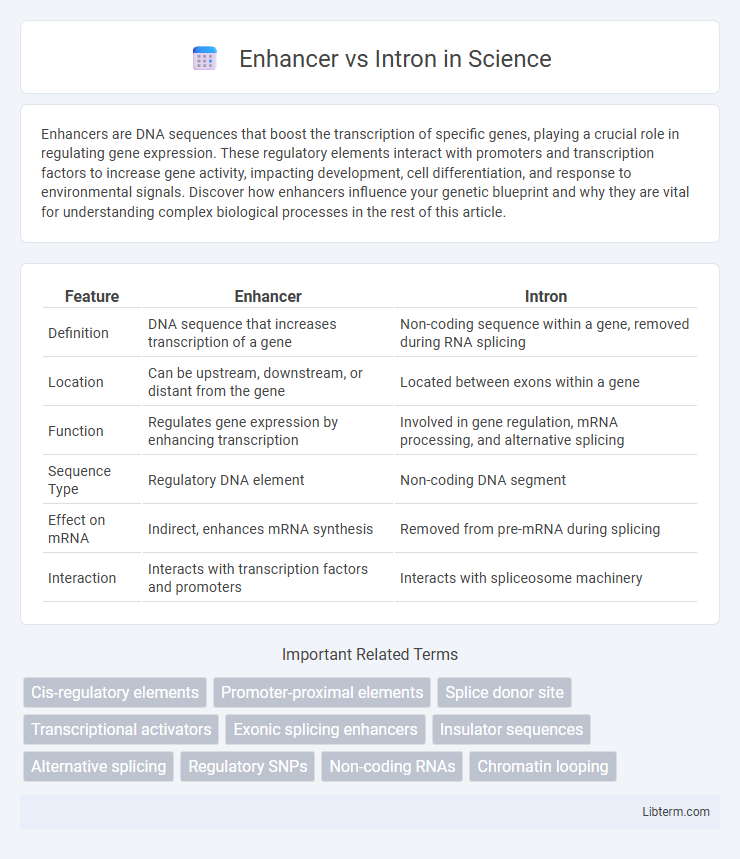Enhancers are DNA sequences that boost the transcription of specific genes, playing a crucial role in regulating gene expression. These regulatory elements interact with promoters and transcription factors to increase gene activity, impacting development, cell differentiation, and response to environmental signals. Discover how enhancers influence your genetic blueprint and why they are vital for understanding complex biological processes in the rest of this article.
Table of Comparison
| Feature | Enhancer | Intron |
|---|---|---|
| Definition | DNA sequence that increases transcription of a gene | Non-coding sequence within a gene, removed during RNA splicing |
| Location | Can be upstream, downstream, or distant from the gene | Located between exons within a gene |
| Function | Regulates gene expression by enhancing transcription | Involved in gene regulation, mRNA processing, and alternative splicing |
| Sequence Type | Regulatory DNA element | Non-coding DNA segment |
| Effect on mRNA | Indirect, enhances mRNA synthesis | Removed from pre-mRNA during splicing |
| Interaction | Interacts with transcription factors and promoters | Interacts with spliceosome machinery |
Introduction to Enhancers and Introns
Enhancers are regulatory DNA sequences that increase the transcription of specific genes by binding transcription factors, often located distally from the gene they regulate. Introns are non-coding sequences within a gene that are transcribed into RNA but removed during RNA splicing before translation. Unlike introns, enhancers do not encode proteins but play a crucial role in gene expression control by influencing promoter activity from variable distances and orientations.
Defining Enhancers: Role and Structure
Enhancers are regulatory DNA sequences that increase the transcription of associated genes by binding transcription factors and facilitating the assembly of the transcriptional machinery. Unlike introns, which are non-coding regions within a gene removed during RNA splicing, enhancers function in a position- and orientation-independent manner, often located distally from the gene they regulate. Structurally, enhancers contain clusters of transcription factor binding sites that enable dynamic and cell-type-specific gene expression control.
Defining Introns: Role and Structure
Introns are non-coding sequences within a gene that are transcribed into precursor mRNA but are removed during RNA splicing, allowing the coding exons to be joined together. These sequences play a crucial role in gene expression regulation by facilitating alternative splicing, which increases protein diversity. Structurally, introns contain conserved splice site sequences at their boundaries and may house regulatory elements affecting mRNA processing and stability.
Key Differences Between Enhancers and Introns
Enhancers are regulatory DNA sequences that increase the transcription of specific genes by binding transcription factors, whereas introns are non-coding segments within a gene that are removed during mRNA splicing. Unlike introns, enhancers can function at considerable distances from the gene they regulate and can be located upstream, downstream, or within introns themselves. Key differences include their roles in gene regulation, with enhancers actively influencing transcription levels and introns primarily involved in gene structure and mRNA processing.
Genomic Location of Enhancers vs Introns
Enhancers are regulatory DNA sequences located distally from the promoter regions they influence, often found tens to hundreds of kilobases away, either upstream, downstream, or within introns of target genes. Introns are non-coding segments situated within the coding sequences of genes, interrupting exons and residing in the primary transcript. The genomic location of enhancers allows them to modulate gene expression over long distances through chromatin looping, whereas introns primarily reside within gene boundaries and are spliced out during mRNA processing.
Functional Importance in Gene Regulation
Enhancers are DNA sequences that significantly boost the transcription levels of specific genes by recruiting transcription factors and co-activators, often operating at considerable distances from the gene promoter. Introns, non-coding regions within genes, influence gene expression by facilitating alternative splicing, mRNA export, and regulatory element embedding, thereby fine-tuning transcript diversity and stability. Both enhancers and introns play crucial roles in gene regulation, with enhancers primarily modulating transcription initiation and introns contributing to post-transcriptional control and expression versatility.
Molecular Mechanisms: How Enhancers and Introns Work
Enhancers are cis-regulatory DNA sequences that increase transcription by recruiting transcription factors and co-activators, facilitating the formation of the transcriptional machinery at promoters through DNA looping. Introns, non-coding sequences within genes, influence gene expression by modulating mRNA splicing, export, and stability, often housing regulatory elements that affect transcription efficiency. Both enhancers and introns contribute to gene regulation, with enhancers primarily acting at the DNA level to boost transcription initiation and introns impacting post-transcriptional processing and transcript diversity.
Impact on Gene Expression
Enhancers significantly increase gene expression by binding transcription factors and facilitating the assembly of the transcriptional machinery at the promoter, often acting at long distances from the gene. Introns primarily influence gene expression through alternative splicing and regulatory elements within their sequences, affecting mRNA diversity and stability. Both elements are crucial for fine-tuning gene expression, but enhancers directly boost transcription levels while introns modulate the transcript's final form and availability.
Enhancers and Introns in Genetic Disorders
Enhancers are regulatory DNA sequences that increase gene transcription and can influence the severity of genetic disorders by altering gene expression patterns. Introns, non-coding regions within genes, play roles in gene regulation and splicing; mutations in introns can disrupt splicing accuracy, leading to aberrant protein production and contributing to genetic diseases. Both enhancers and introns are crucial in the molecular mechanisms underlying hereditary conditions, affecting gene function without altering coding sequences directly.
Future Research Directions
Future research on enhancers and introns should prioritize high-resolution mapping of their dynamic interactions across diverse cell types using single-cell multi-omics technologies. Investigating the regulatory roles of non-coding intronic regions in enhancer-mediated gene expression can reveal novel mechanisms of transcriptional control and their implications in disease. Integrating CRISPR-based genomic screens with computational models may uncover functional variants within enhancers and introns, guiding precision medicine approaches.
Enhancer Infographic

 libterm.com
libterm.com